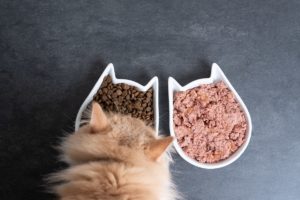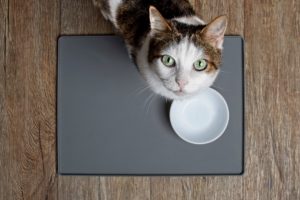Written by: Allison Ward
Now that you’re familiar with the numerous important jobs that your cat’s kidneys do for them, it’s time to discuss how we can help cats with kidney disease. If your cat has been diagnosed with acute (sudden) or chronic (long-term) kidney disease, read on to learn how to treat kidney disease in cats and help them live their best life for as long as possible.
Consult Your Veterinarian About Any Recent Medications/Supplements
If your cat has recently been given medications, over-the-counter products, or supplements, make sure to inform your veterinarian. Many medications and supplements can cause the kidneys to work harder and may need to be stopped or reduced in dosage. If your cat is in acute (sudden) kidney failure, look around your household/garage to see if there is ANY possibility of your cat swallowing something toxic, like antifreeze. If you have any suspicions of your cat ingesting a toxic substance, speak with a veterinarian immediately.
Fluid Therapy
As you know, one of the most important jobs that kidneys perform is filtering toxins out of the bloodstream and creating urine to further flush these from the body. In cats with kidney disease, this highly specific and balanced filtration process is impaired, causing toxins to build up in the bloodstream and fluids to be lost. When the kidneys do not function normally, your kitty will produce an increased amount of urine in order to flush these toxins out. Even if you notice her drinking more than usual, this situation can easily lead to dehydration.
When cats are dehydrated, they will become lethargic and feel very sick. A sick kitty will often stop eating and may drink less water too —intensifying that level of dehydration. On top of your kitty feeling crummy, the kidneys have lost the ability to conserve water so all of that precious fluid is ending up in the litterbox instead of hydrating their bodies. For these reasons, it’s important to make sure that any cat with kidney disease continues to be well-hydrated and to also correct any dehydration by administering extra fluids in order to help her body function as normally as possible.
Fluid Therapy in Acute Kidney Failure
In cats with sudden or acute kidney failure (or “acute renal failure”), this often means hospitalization for 24 to 72 hours (and sometimes longer). An intravenous catheter, or IV, is placed in a vein inside your cat’s front leg and fluids are delivered directly into the vein. This is the fastest way to hydrate your kitty and add the electrolytes back to the bloodstream that they may be lacking. Your kitty is monitored very closely with lab testing. As your cat’s hydration needs change, the rate of fluid being delivered into his system can be adjusted–sometimes even hour-by-hour. Don’t worry, though–the veterinarian taking care of your cat will make sure his fluid therapy is optimized to help him go home and be out of the hospital as quickly as possible!
Fluid Therapy in Chronic Kidney Disease
With chronic kidney disease, extra fluids are not usually needed in the early stages because the kidneys are still doing a pretty good job on their own. However, since chronic kidney failure is often progressive and worsens over time, your cat may eventually need to receive fluids at home. If your veterinarian recommends this type of treatment, don’t worry—your vet won’t expect you to place an IV! Instead, we utilize the space underneath all of that loose skin your kitty has and deposit fluid directly below the skin.
This is called “subcutaneous fluids,” or “subcu fluids” for short, and the pocket of fluids looks like a little hump on their back. This fluid pocket is slowly absorbed over through the day and helps your kitty’s body receive that extra “drink of water”. This procedure is easier than it sounds and most cats tolerate it very well! Many tutorial videos are available on YouTube if you’re curious as to how this is done.
Kidney Diets
Your veterinarian may recommend transitioning your cat to a prescription kidney diet. These foods are specially formulated to minimize the work of the kidneys by containing protein, mineral, and electrolyte levels optimized to help those kidneys function. They are also specially balanced to provide nutrients for healthy metabolism and maintaining muscle mass, while containing beneficial fatty acids and antioxidants. All of these ingredients help kitty kidneys last longer.
In general, the moisture and nutrients present in canned food are more helpful to struggling kidneys than dry food. If your cat is used to the crunch of dry food, try the dry version of a kidney diet and gradually add more and more water to the kibble over time. Any extra water your cat can get just by eating and drinking will help with hydration and reduce stress on sick kidneys!
AskVet Tip: Some kitties love sneaking sips of water in different areas around the house! Leaving that bathroom faucet on a slow drip into a small cup, investing in a kitty water fountain, or putting accessible sources of water out at various locations around the house may entice your kitty to stop for additional drinks throughout their day.
Medications for Upset Stomach/Appetite Stimulants
Sometimes, cats with kidney problems need some help in the stomach department, too! Dehydration and the buildup of toxins in the bloodstream can cause a cat to eat less than normal, or even to start vomiting. Once this happens, then your cat can become MORE dehydrated, since she isn’t taking in any moisture (and may be losing fluid through vomiting).
Therefore, it’s very important to recognize changes in your cat’s appetite early on and alert your vet if you feel your cat is eating less, or if she starts vomiting. Medications such as antacids and nausea medication can be given to reduce any nausea your cat may be experiencing. Sometimes, veterinarians will dispense a longer-term supply of these medications for you to have on hand in case there’s a problem.
In some cats who are not eating enough to prevent weight loss, or who are eating irregularly in spite of nausea medications, appetite stimulants can be prescribed. The most common is a medicated ointment that you smear inside your cat’s ear flap once a day called Mirataz. Another effective option is a once-daily liquid given by mouth called Elura. Your veterinarian can help you decide when and how often to use either of these medications.
Blood Pressure Medication
As we discussed in our article on signs of kidney disease in cats, medications are sometimes needed to control high blood pressure. Since high blood pressure can further damage the kidneys over time, it’s essential to recognize high blood pressure early on. These medications are usually given one to two times per day and include medications such as amlodipine and telmisartan.
Reducing Urine Protein
As the kidneys continue to deteriorate, some kitties will experience the loss of protein from the bloodstream into the urine due to the damaged and leaky filtration system. Your veterinarian can perform a test on your cat’s urine called a “urine protein/creatinine ratio” which determines if excessive protein is being lost into the litterbox.
The urine protein/creatinine ratio is a helpful indicator of the severity of your kitty’s kidney disease — the higher the ratio, the more protein is being lost. Minimizing this loss is very important and can be managed with medications like telmisartan, enalapril, and benazepril. Not all cats with kidney disease will need medication for excess urine protein, however–some leaky kidneys still keep the protein in the body where it needs to be.
Calcium and Phosphorus Balance
One of the most important functions of the kidneys involves regulating the amount of calcium and phosphorus in the body. You may be familiar with calcium and phosphorus as minerals that are essential to building strong bones—but the kidneys play an important role in regulating just the right balance of these two minerals! If the calcium level is creeping up in your kitty’s bloodstream due to kidney disease, a medication called calcitriol has been proven to help kidney patients survive longer by helping the kidneys achieve appropriate calcium levels.
Phosphorus is another mineral that can cause nausea and damage to organs around the body if the level in your cat’s bloodstream is too high. For this reason, prescription kidney diets are low in phosphorous to reduce the amount of work your cat’s kidneys need to accomplish! As kidney disease worsens over time,, your vet may recommend starting a medication such as aluminum hydroxide to help your kitty excrete more phosphorus.
Monitoring Kidney Disease
We know this list of therapies for cats with kidney disease probably seems overwhelming to you right now! Fortunately, very few cats need ALL of these different interventions. In early stages of kidney disease, for example, your veterinarian may recommend switching to a prescription kidney diet and repeating some lab work in a month or two. We can never be sure how quickly an individual patient’s kidneys will deteriorate, so rechecking lab work could be recommended on a monthly basis, every three months, or every six months.
Here are some tests your veterinarian may recommend to monitor your cat’s kidney status after they have been diagnosed with kidney disease:
Bloodwork
Evaluates levels of toxins in the bloodstream that should be filtered out of the body through the kidneys. Examples include BUN (blood urea nitrogen), CREA (creatinine), PHOS (phosphorous), and CA (calcium). Increases in these numbers mean that the kidneys are struggling. Bloodwork can also tell us about the protein levels in your cat’s bloodstream, electrolyte levels, and red blood cell/white blood cell counts.
Urinalysis
Evaluates the ability of the kidneys to concentrate urine, as well as monitoring for evidence of active kidney damage (“casts” in the urine) and evidence of infection in the urinary tract.
Urine Protein/Creatinine Ratio
Evaluates whether the cats kidneys are letting too much protein out of the body into the urine
Urine Culture
The gold standard test for urinary tract infection, this test requires a sterile urine sample to be collected in the clinic and then waiting for bacteria to grow in the urine sample. Cats with kidney disease are more vulnerable to infections, and infections can worsen kidney disease. Many veterinarians recommend performing this test every 6 months, even if no clinical signs or symptoms are currently noticed at home.
Blood Pressure
As kidney disease worsens over time, your cat’s blood pressure will likely increase. Sometimes this doesn’t happen for a year or two after diagnosis of chronic kidney disease, but catching this medical condition early can save your cat’s life. Therefore, many veterinarians recommend monitoring a kidney patient’s blood pressure at least every 6 months.
The Bottom Line
Your AskVet veterinarians know that kidney disease can be overwhelming and confusing—and we are here to help! If you have any questions about your cat’s medical condition, or are wondering whether your cat with kidney disease needs urgent attention, then all you have to do is Ask Vet. We are here 24/7 to help you and your cat!
Written by:
Allison Ward, DVM
Dr. Allison Ward grew up in the suburbs of Washington, D.C. and started working in veterinary hospitals when she was 14 years old. After graduating from veterinary school in 2011, she completed a small animal rotating internship in New Jersey, followed by a neurology/neurosurgery internship in Miami. After completing this advanced training, Dr. Ward then moved on to general small animal practice. Dr. Ward’s professional interests include feline medicine, neurology, and pain management. Her passion for educating pet owners carries over into her work with AskVet, and she loves being able to help pets and their parents at all times of the day (and night!). She currently resides in sunny south Florida with her two cats, Larry and George.








